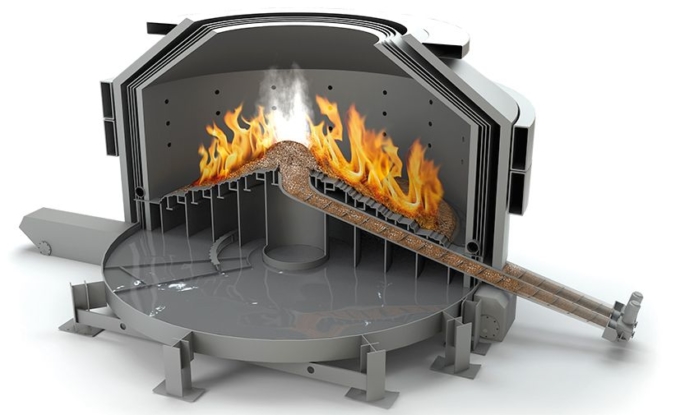Fuel
In practice, sawmills always have more fuel than they need as only about one third of the sawdust and bark produced is used in their heating plants.
The moisture content of the fuel has great significance for the performance of the heating plant. The fuel must not be too wet but also not too dry. Fuel that is too wet will not burn while fuel that is too dry may burn too strongly.
In general, a moisture content of 45–60% is optimal. Especially in the winter in Finland, moisture content tends to be closer to the upper limit of that optimal range.
Grate and fluidised bed technology
The most commonly used technology at sawmill heating plants is grate technology where woodbased biomass is spread on a grate to be burned. The fuel moves along the grate as it burns, and the remaining ash is collected from underneath and behind the grate or as fly-ash from the flue gas.
There are different types of grates. For example, there are rectangular inclined grates or cone grates that are more efficient.

© KPA Unicon
Another burner type that is particularly popular in the Nordic countries is based on fluidised bed technology. In fluidised bed technology, the fuel is fed into a furnace where it is mixed with hot, fine sand. The consistency of the fuel must also be fine because the fuel is fluidised among the sand using a special fluidiser. The purpose of the sand is to even out the temperatures and burning in the entire combustion chamber.
[arve url=”https://www.youtube.com/watch?v=WNugfZLcCCg”]
Types of boilers
Regardless of the type of combustion, water is heated in a steam or hot water boiler. There are three types of boilers:
1. plate convection boilers,
2. 3-pass fire-tube boilers and
3. water tube boilers.
In plate convection boilers, flue gas is directed through the angular convection section where the plate structure contains a boiler. Plate convection boilers are only suitable for smaller plants with low pressures (below 10 bar) and thermal output (below 4MWth).
In 3-pass fire-tube boilers, the hot flue gases are directed through the passes and tubes. There is water in the cylinder container around the passes and tubes and the temperature of the water rises as the tubes heat up.
Water tube boilers operate in the opposite way. Water runs in the boiler’s tubes while flue gases are directed into the space around the tubes.
The output and pressure range of 3-pass firetube boilers is typically 4–10MWth and 6–16 bar. The upper output and pressure range of water tube boilers is practically never reached at sawmills.
Plant operation
Advanced automation systems enable unmanned use of plants in normal situations. The presence of operators is necessary only during the start-up and shutdown stages. Modern heating plants require servicing for around two weeks during the year.
Monitoring continuous and periodic use
The registered steam and hot water boilers in a boiler plant must be monitored either continuously or periodically.
Periodic monitoring is allowed for:
- max. 20MW steam boilers that use solid fuels or where the amount of energy stored in the furnace may damage the boiler during a disruption
- other max. 40MW steam boilers
- max. 120MW hot water boilers

